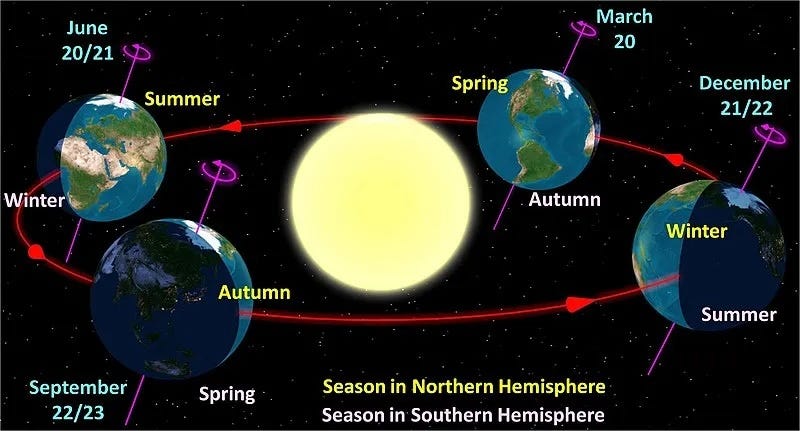Understanding the Science Behind the Summer Solstice
Written on
Chapter 1: The Essence of the Summer Solstice
The term "solstice" derives from the Latin word "solstitium," which translates to "Sun standing still." The Summer Solstice marks the moment when the Sun reaches its highest point in the sky, occurring on June 20 at 20:51 UTC (Coordinated Universal Time), which is also known as Zulu Time or Greenwich Mean Time. The prime meridian, situated in Greenwich, England, serves as the reference point for longitude.
Why is UTC referred to as Coordinated Universal Time? The abbreviation emerged from a compromise between English and French speakers. In English, it would typically be abbreviated as CUT, while in French, the term is Temps Universel Coordonné, which shortens to TUC.
Section 1.1: Summer Time and Its Cultural Significance
This period is often called the Northern Solstice because the Sun is directly overhead at the Tropic of Cancer in the Northern Hemisphere. While the Summer Solstice is typically recognized as the onset of summer, the actual celebration of Midsummer occurs on June 24, due to variations between the Julian and Gregorian calendars. Many Christian festivities coincide with this time, particularly those celebrating the Birth of St. John the Baptist. In countries like Bolivia and Peru, this season is celebrated with the Festival of San Juan.
Subsection 1.1.1: Does Summer Begin on the Summer Solstice?
In short, yes. However, there's a more nuanced explanation. Some individuals consider Memorial Day, which falls at the end of May, as the "unofficial" start of summer. This perspective is grounded in tradition rather than science. While the Solstice represents the beginning of astronomical summer, meteorological summer begins on June 1.

Section 1.2: Understanding Meteorological Seasons
Meteorological seasons differ from astronomical ones, which are determined by the Earth’s position relative to the Sun. In contrast, meteorological seasons are based on the annual temperature cycle. The field of astronomy is ancient, but modern meteorology has evolved significantly since the 18th century, gaining prominence through climate research. Meteorological observations led to the establishment of seasons that align more closely with our civil calendar.
The National Centers for Environmental Information indicates that each season lasts approximately 90 days for winter in a non-leap year, and 92 days for both spring and summer. Meteorologists categorize the seasons into three-month periods based on the temperature cycle and calendar: meteorological spring (March, April, May), summer (June, July, August), fall (September, October, November), and winter (December, January, February).
Chapter 2: The Science of the Summer Solstice
The reason Earth experiences varying seasons is due to its tilt of approximately 23 degrees and 27 minutes relative to its orbital plane. This tilt causes the Earth to rotate like a tilted spinning top. The Summer Solstice represents the longest day of sunlight for the Northern Hemisphere, with the Sun at its zenith.
The farther one is from the Equator, the more pronounced the effects of this phenomenon during summer. As Earth continues its orbit, the hemisphere tilted towards the Sun shifts, reversing the seasons. Around the time of the Summer Solstice, the Sun appears at its highest elevation in the sky, maintaining this position for several days before and after. This phenomenon gives the impression that the Sun is "standing still," only to begin its descent as days shorten and nights lengthen.
Video Description: This video titled "Science at Play: Summer Solstice" delves into the scientific principles underlying the Summer Solstice, exploring its significance in nature and culture.
Video Description: The second video, "The Longest Day of the Year: The Solstice!" examines the historical and cultural importance of the Summer Solstice, highlighting various global celebrations.
Summer Solstice Know-It-All Facts
Impress your friends and family with these intriguing facts about the Summer Solstice: - Contrary to popular belief, the Summer Solstice is not the longest day of the year; it merely has the most daylight. The longest day occurs in November when we adjust our clocks for Daylight Saving Time, giving us an extra hour. - Interestingly, the Earth is actually at its farthest distance from the Sun during the Summer Solstice. - On the Summer Solstice, your shadow at noon will be the shortest it will be all year. - In Fairbanks, Alaska, residents can enjoy nearly 24 hours of sunlight on the Summer Solstice, leading to unique traditions such as midnight baseball games.
For more insights and articles, consider subscribing to Bill Petro's newsletter at billpetro.com. Your feedback is welcome, and we encourage you to leave comments if you found this information engaging.